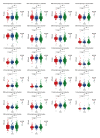Longitudinal Evaluation of Metabolic Benefits of Inactivated COVID-19 Vaccination in Diabetic Patients in Tianjin, China
- PMID: 40287793
- PMCID: PMC12042708
- DOI: 10.12659/MSM.947450
Longitudinal Evaluation of Metabolic Benefits of Inactivated COVID-19 Vaccination in Diabetic Patients in Tianjin, China
Abstract
BACKGROUND Diabetes significantly heightens risks of COVID-19 infection, and vaccine hesitancy remains high due to safety concerns. MATERIAL AND METHODS This study assessed the effects of inactivated COVID-19 vaccine in 548 diabetic patients from Tianjin, China, categorized by vaccination status: unvaccinated (n=94), primary immunization (n=117), and booster immunization (n=337). A total of 22 clinical values were assessed prior to vaccination, 3 months after vaccination, and 12 months after vaccination. Variables with a normal distribution were compared across groups using one-way ANOVA, while non-normally distributed variables were compared using the Kruskal-Wallis test and chi-square tests for categorical data. Linear mixed-effects models were used to evaluate the effects of time and vaccine type on these clinical values, with random intercepts to account for within-subject variability and interaction terms for detailed group comparisons over time. RESULTS Baseline results showed no major differences across groups, including fasting glucose, HbA1c, granulocytes, hemoglobin, platelets, renal function markers such as uric acid, creatinine, and eGFR. Booster vaccination significantly reduced FPG (Estimate=-0.123, p<0.001) and HbA1c (Estimate=-0.049, p<0.01), with primary vaccination also reducing FPG (Estimate=-0.118, p<0.001) and HbA1c (Estimate=-0.040, p<0.05). However, creatinine decreased and bilirubin levels rose in vaccinated groups but remained within the normal physiological range. Other indicators showed no significant changes. CONCLUSIONS In conclusion, COVID-19 inactivated vaccine can provide metabolic benefits for diabetic patients.
Conflict of interest statement
Figures



Similar articles
-
The effectiveness of booster vaccination of inactivated COVID-19 vaccines against susceptibility, infectiousness, and transmission of omicron BA.2 variant: a retrospective cohort study in Shenzhen, China.Front Immunol. 2024 May 31;15:1359380. doi: 10.3389/fimmu.2024.1359380. eCollection 2024. Front Immunol. 2024. PMID: 38881892 Free PMC article.
-
Longitudinal assessment of immunogenicity of inactivated COVID-19 booster immunization and breakthrough infection in blood donors: A multicenter study from 2021 to 2023.Hum Vaccin Immunother. 2025 Dec;21(1):2498828. doi: 10.1080/21645515.2025.2498828. Epub 2025 May 5. Hum Vaccin Immunother. 2025. PMID: 40323225 Free PMC article.
-
Safety, tolerability, and immunogenicity of an aerosolised adenovirus type-5 vector-based COVID-19 vaccine (Ad5-nCoV) in adults: preliminary report of an open-label and randomised phase 1 clinical trial.Lancet Infect Dis. 2021 Dec;21(12):1654-1664. doi: 10.1016/S1473-3099(21)00396-0. Epub 2021 Jul 26. Lancet Infect Dis. 2021. PMID: 34324836 Free PMC article. Clinical Trial.
-
A randomized, double-blind, placebo-controlled phase III clinical trial to evaluate the efficacy and safety of SARS-CoV-2 vaccine (inactivated, Vero cell): a structured summary of a study protocol for a randomised controlled trial.Trials. 2021 Apr 13;22(1):276. doi: 10.1186/s13063-021-05180-1. Trials. 2021. PMID: 33849629 Free PMC article.
-
Safety, tolerability, and immunogenicity of an inactivated SARS-CoV-2 vaccine in healthy adults aged 18-59 years: a randomised, double-blind, placebo-controlled, phase 1/2 clinical trial.Lancet Infect Dis. 2021 Feb;21(2):181-192. doi: 10.1016/S1473-3099(20)30843-4. Epub 2020 Nov 17. Lancet Infect Dis. 2021. PMID: 33217362 Free PMC article. Clinical Trial.
References
-
- Morrish NJ, Wang SL, Stevens LK, et al. Mortality and causes of death in the WHO Multinational Study of Vascular Disease in Diabetes. Diabetologia. 2001;44(Suppl 2):S14–21. - PubMed
-
- Rubin EJ, Baden LR, Barocas JA, Morrissey S. Audio interview: SARS-CoV-2 vaccination and vulnerable populations. N Engl J Med. 2020;383(24):e143. - PubMed
MeSH terms
Substances
LinkOut - more resources
Full Text Sources
Medical
Research Materials
Miscellaneous

